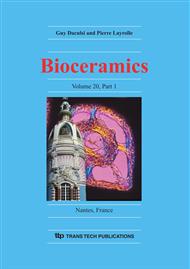p.483
p.487
p.491
p.495
p.499
p.503
p.507
p.511
p.515
A Novel Approach of Homogenous Inorganic/Organic Composite through In Situ Precipitation in Gelatine/Poly(Acrylic Acid) Gel
Abstract:
A new in situ precipitation technique was developed to promote high-affinity nucleation and growth of calcium phosphate in the polymer hydrogel. Gelatine/poly(acrylic acid)/hydroxyapatite (HA) composite has been prepared using template-driven reaction. Nano-sized hydroxyapatite particles were distributed within organic template homogenously, furthermore, inorganic particles were fine and uniform. During the composite process, 3D network of organic matrices and homogenous distributed nucleation sites played an important role in the superfine interaction of HA and hydrogel. This method provides an efficient approach toward inorganic/organic nanocomposites with high-uniformity decentralization for biomimetic replant applications. This paper discussed the mechanism of the reaction, and the concept of in situ precipitation in gel was brought forward.
Info:
Periodical:
Pages:
499-502
Citation:
Online since:
November 2007
Authors:
Price:
Сopyright:
© 2008 Trans Tech Publications Ltd. All Rights Reserved
Share:
Citation:


